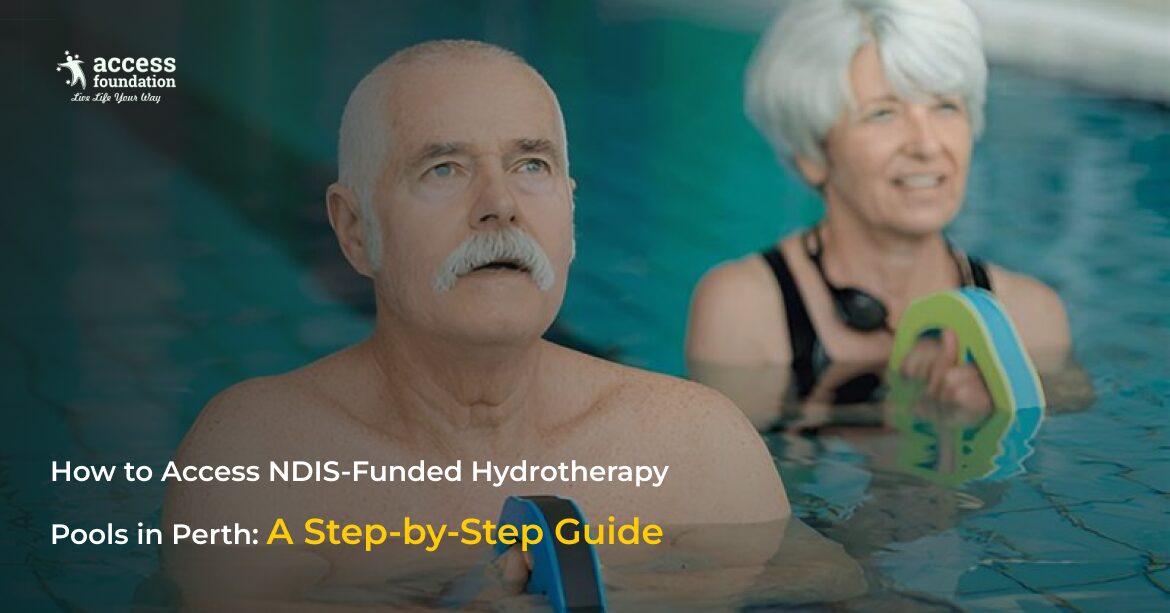
Hydrotherapy has come to be one of the most transformative and handy supports underneath the National Disability Insurance Scheme (NDIS). It’s a therapy designed to enhance mobility, reduce ache, and sell rehabilitation — all while being finished inside the supportive environment of an NDIS hydrotherapy pool.
However, now not every hydrotherapy carrier offers the identical degree of high-quality, protection, and effectiveness. What sincerely determines the achievement of hydrotherapy isn’t simply the water itself — it’s the human beings handing over the care, the facilities that make sure accessibility, and the safety measures that defend individuals.
In this distinctive guide, we’ll explore how qualified staff, right infrastructure, and rigorous protection protocols work collectively to create a powerful hydrotherapy enjoy. Understanding those factors will assist you select the right issuer and get the most out of your NDIS-funded hydrotherapy classes.
Understanding Hydrotherapy: A Quick Overview
Hydrotherapy (also called aquatic physiotherapy) is a shape of healing workout performed in warm water. The combination of buoyancy, resistance, and warmth helps individuals achieve physical hobby and relaxation in methods which might be difficult to copy on land.
Hydrotherapy is mainly useful for people living with:
Cerebral palsy
Multiple sclerosis
Stroke or spinal twine injuries
Arthritis or persistent ache
Mobility or stability demanding situations
The water’s herbal buoyancy helps body weight, reducing pressure on joints at the same time as offering resistance for muscle strengthening. The warm temperature promotes rest, blood drift, and ache alleviation. Together, those results lead to advanced mobility, confidence, and first-rate lifestyles.
Why Qualified Staff Are the Backbone of Hydrotherapy
A first-rate hydrotherapy revel in starts off evolved with skilled and compassionate specialists. Hydrotherapy isn’t simply swimming or exercise — it’s a specialised, medical therapy that requires expert steering.
1. Professional Expertise and Accreditation
Qualified therapists — often physiotherapists, occupational therapists, or exercise physiologists — are educated to layout and supply tailor-made hydrotherapy programs. They apprehend anatomy, rehabilitation principles, and the particular needs of every player.
These professionals assess your mobility, set sensible dreams, and regulate exercises in step with development and luxury levels. Their schooling ensures safe, evidence-primarily based practice that minimizes danger and maximizes effects.
2. Personalized Treatment Plans
Each player’s situation and goals are unique. A certified therapist designs a personalized plan that could encompass stretching, stability work, electricity physical activities, or pain control strategies.
For example:
A participant with arthritis might be aware of mild flexibility in physical games.
Someone recuperating from surgery might paint on slow mobility and muscle activation.
Without certified supervision, such individualized care wouldn’t be feasible — and the threat of stress or damage might grow.
3. Monitoring and Progress Evaluation
A qualified group of workers usually examine contributors’ overall performance and comfort at some stage in periods. They track progress via measurable indicators which include mobility variety, endurance, and ache discount.
They also offer documented reports — essential for NDIS plan reviews and continued funding. This based method ensures responsibility and ongoing improvement.
4. Safety and Emergency Readiness
Certified therapists are educated to deal with emergencies, monitor important symptoms, and apprehend symptoms of fatigue or distress. Their presence affords peace of thoughts to contributors and carers, ensuring a safe and supportive environment.
The Importance of High-Quality Facilities
The bodily surroundings perform an important function in hydrotherapy’s fulfillment. The first-rate effects are achieved in a well-designed, cause-constructed facility that prioritizes accessibility, comfort, and hygiene.
Let’s study the key elements that make a facility stand out:
1. Accessibility for All Participants
A hydrotherapy pool has to accommodate individuals with all ranges of capacity. Accessibility is extra than simply ramps — it’s approximately growing an inclusive surroundings where each player feels empowered and independent.
Essential accessibility functions consist of:
Ramps, pool hoists, or lifts for safe access and exit.
Non-slip floors to prevent falls.
Wide walkways and doors for wheelchairs get right of entry too.
Accessible change rooms with take hold of rails and adjustable benches.
An inclusive setup ensures comfort from arrival to departure, decreasing tension and making therapy extra enjoyable.
2. Water Temperature and Quality
The perfect hydrotherapy pool keeps a water temperature of 33°C–35°C, growing a soothing and therapeutic environment.
Warm water:
Relaxing muscles.
Promotes circulate.
Reduces stiffness and joint pain.
Proper water management is equally crucial. Regular trying out for pH, chlorine, and bacterial levels ensures hygiene and safety for all users.
3. Facility Maintenance and Cleanliness
Cleanliness isn’t non-compulsory — it’s crucial. High-satisfactory facilities follow strict upkeep schedules, ensuring pool systems, floors, and converting regions are sanitized and functional.
Signs of a well-maintained facility encompass:
Clear, easy water.
Odor-loose pool location.
Regular maintenance logs.
Hygienic alternate and bathe rooms.
Participants deserve a safe, hygienic space that promotes recuperation, not health risks.
4. Supportive Environment
The ambiance of the facility subjects, too. Great hydrotherapy centers layout their areas to sell relaxation and dignity — with calming colorings, proper lighting fixtures, and cushty seating for carers.
An experienced NDIS hydrotherapy provider in Perth will make sure centers meet these high requirements, combining current infrastructure with inclusive layout to help each participant.
The Role of Safety in Hydrotherapy
Hydrotherapy offers numerous blessings — however without proper safety protocols, even a small oversight can result in injuries or health problems. Safety isn’t just about having lifeguards; it’s a mixture of facility requirements, personnel schooling, and participant consciousness.
1. Supervision and Staffing Ratios
Every consultation must be supervised by means of a certified therapist or educated hydrotherapy assistant. The proper workforce-to-player ratio guarantees personal attention and immediate response in case of emergency.
Therapists screen signs and symptoms of fatigue, respiratory adjustments, or discomfort, adjusting physical activities or taking breaks while wished.
2. Emergency Protocols
Reputable facilities have clear, documented emergency processes, including:
Accessible emergency exits and alarms.
First aid and resuscitation equipment.
Staff trained in CPR and emergency response.
Regular drills and protection tests make certain readiness at all times.
3. Risk Assessments
Before beginning hydrotherapy, participants go through a man or woman danger evaluation to discover scientific conditions, medicinal drugs, or balance problems that can have an effect on therapy.
This proactive method prevents complications and ensures classes are designed round protection wishes.
4. Water Hygiene and Sanitation
Contaminated or poorly maintained swimming pools pose health dangers including pores and skin irritations or infections. Great carriers test and stabilize water frequently, following Australian requirements for hydrotherapy protection.
5. Equipment Safety
Every piece of gadget — from floats to hoists — needs to be inspected regularly. Staff ensure devices are practical and suitable to each player’s desires.
An expert environment removes pointless risks, allowing participants to cognizance completely on development.
How These Elements Work Together
The actual achievement of hydrotherapy lies inside the synergy among certified specialists, nicely-ready facilities, and strict protection standards.
When those three pillars align, individuals revel in:
Improved fitness effects: Consistent development thru based therapy.
Confidence and comfort: Feeling secure, reputable, and supported.
Efficiency in investment: NDIS funds are used for powerful, measurable therapy.
Enhanced independence: Improved physical talents leading to day by day existence advantages.
Every issue — from water best to workforce know-how — performs an essential position in growing a holistic, empowering revel in.
How to Identify a High-Quality Hydrotherapy Provider
With such a lot of hydrotherapy options available, deciding on the right company can be overwhelming. Here’s what to search for when comparing services:
1. Accreditation and Registration
Work with registered NDIS provider carriers who follow authentic guidelines. Registered carriers assure transparency, fine, and responsibility underneath the NDIS framework.
2. Qualified and Experienced Staff
Ask approximately the credentials of the therapy team. Verify that physiotherapists or occupational therapists are licensed and experienced in aquatic therapy.
3. Transparent Communication
Good carriers communicate honestly approximately consultation structure, pricing, progress reporting, and scheduling. Transparency builds accept as true with and guarantees you apprehend how your NDIS funding is used.
4. Participant-Centered Approach
Every wonderful issuer prioritizes your needs. They adapt exercises, listen to comments, and inspire participation at your pace.
5. Proven Track Record
Look for critiques, testimonials, or case studies demonstrating fine outcomes. Real-international achievement tales reflect professionalism and care high-quality.
In Perth, selecting an established NDIS hydrotherapy provider in Perth ensures entry to trusted specialists who combine knowledge, safety, and innovation in each session.
The Long-Term Impact of Safe, Professional Hydrotherapy
When done beneath proper supervision in a high-quality surroundings, hydrotherapy leads to measurable, long-term upgrades. Participants frequently report:
Reduced persistent ache.
Greater mobility and power.
Enhanced self assurance in bodily interest.
Improved emotional health and independence.
Moreover, a secure and established therapy helps save you relapses or injuries, promoting steady progress over months or years.
The sense of accomplishment won thru hydrotherapy regularly extends beyond the pool — empowering members to re-have interaction with pursuits, network, and daily life.
Final Thoughts
Hydrotherapy is a way greater than just physical exercising — it’s a cautiously coordinated therapy that relies upon 3 important pillars: certified workforce, high-quality facilities, and uncompromising safety requirements. Together, these elements rework a simple water session into a lifestyle-changing enjoy.
When added in a well-maintained NDIS hydrotherapy pool, hydrotherapy becomes a gateway to electricity, self assurance, and independence. Partnering with expert NDIS service providers guarantees you receive care that is safe, personalised, and powerful. And for the ones in Western Australia, deciding on a good NDIS hydrotherapy provider in Perth guarantees right of entry to global-magnificence centers, skilled therapists, and community-targeted care.
Because authentic recuperation in hydrotherapy doesn’t happen through threat — it occurs via professionalism, precision, and people who care.


